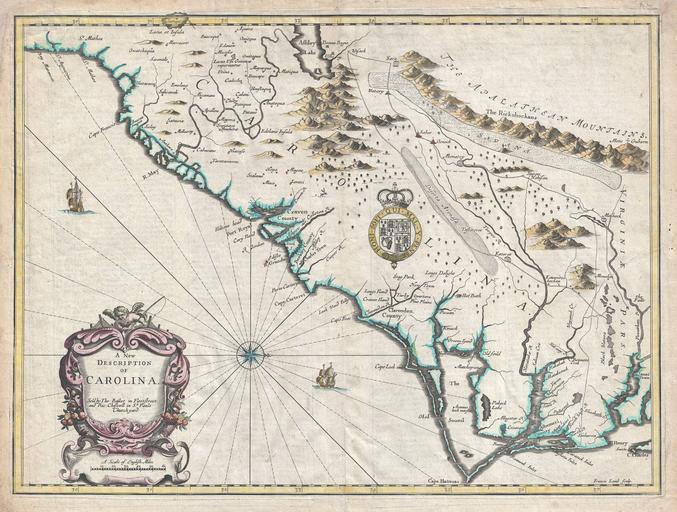MAKE A MEME
View Large Image

| View Original: | 1676_John_Speed_Map_of_Carolina_-_Geographicus_-_Carolina-speed-1676.jpg (5000x3783) | |||
| Download: | Original | Medium | Small | Thumb |
| Courtesy of: | commons.wikimedia.org | More Like This | ||
| Keywords: 1676 John Speed Map of Carolina - Geographicus - Carolina-speed-1676.jpg A beautiful example of John Speed's important 1676 map of the Carolina colony Heavily based upon the explorations of John Lederer and Ogilby's Lords Proprietor's Map of 1674 This seminal map represents one of the earliest attempts to map the Carolina interior Oriented to the West map covers from the Spanish colony of St Augustine Florida north to Jamestown Virginia Extends inland as far as the Appellation Apalathean Mountains By the middle of the 17th century the coast of Carolina had been fairly well mapped St Augustine Port Royal Charleston Charles Town Cape Fear Cape Lookout Cape Hatteras Roanoke Cape Henry and the James River are all shown with a fair approximation of accuracy We see ample evidence of the Lords Proprietors including Albemarl County Clarendon County Berkley County Craven County etc This map also incorporates numerous elements from earlier maps including Lake Sarrope which was identified by the De Bry - Le Moyne map of 1565 and most likely represents Lake Okeechobee Also shows the River May historically either the St John's River or the Savannah River depending on the map Where this map really gets interesting is the interior which is heavily based upon the explorations of John Lederer in the 1670s Lederer a German physician who had moved to the colony several years before was commissioned by the Lord Proprietor Anthony Ashley Cooper Earl of Shaftesbury to explore the interior in search of a pass beyond the mountains to the Pacific As the time it was commonly assumed that the mainland of North America was a relatively narrow strip of land that could be traversed swiftly easily to access the rich trade opportunities of the Pacific Though Lederer never managed to cross the Appellations he did undertake three voyages which significantly impacted cartography in this region for several hundred years Today Lederer is highly criticized for fabricating much of his journey and a cursory examination of the map will reveal what might seem to be several gross cartographic errors including a great savanna in the Piedmont the Deserta Arensa and Ashley Lake in the north Lederer's route is roughly traced on this map as he heads almost directly west from the Falls of the James River before turning southwest at the Mahock village near Richmond Keeping to a southwesterly course Lederer passes a great savanna on his right and ultimately finds himself on the shores of Ashley Lake which he calls Ushery and which on our map corresponds with the Great Freshwater Lake of the American Southwest popularized by the 1606 Mercator - Hondius Map At this point Lederer returns along a parallel but more easterly course passing through a great sandy desert the Deserta Arenosa before returning to known lands Many scholars have argued that Lederer simply lied about many of his findings but we find that much of what he said when taken in the context of lonely explorer traversing an unknown land several hundred years ago has merit Lederer's desert the Arenosa probably corresponds the Sand Hills region though he does slightly exaggerate the scope Some scholars criticize the desert as according to his narrative Lederer spent several days on the desert before encountering water Given the geography of the Sand Hills as we know it it would seem likely that he would have such difficulty finding water but his placement of the desert compared with the actual placement of the Sand Hills remains convincing The savanna in the piedmont region is non-existent today though something very much like this may have existed in Lederer's day Lederer describes this savanna as marish grounds at the foot of the Apalataei 1676 undated Size in 20 15 object history credit line accession number Carolina-speed-1676 Speed J <i>The Theater of the Empire of Great Britian</i> 1676 Also in Speed J <i>A Prospect of the Most Famous Parts fo the World ¦</i> 1676 Geographicus-source PD-Art-100 1676 maps Old maps of Florida Old maps of North Carolina Old maps of South Carolina Old maps of Virginia John Speed Appalachian Mountains Maps in English Cape Charles Virginia | ||||